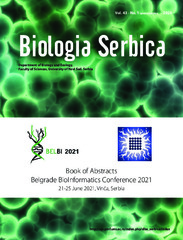| dc.contributor | Matavulj, Milica | |
| dc.creator | Malešević, Milka | |
| dc.creator | Rašić, Slađan | |
| dc.creator | Santra, Violeta | |
| dc.creator | Kojić, Milan | |
| dc.creator | Stanisavljević, Nemanja | |
| dc.date.accessioned | 2023-05-22T11:15:47Z | |
| dc.date.available | 2023-05-22T11:15:47Z | |
| dc.date.issued | 2021 | |
| dc.identifier.issn | 2334-6590 | |
| dc.identifier.uri | https://imagine.imgge.bg.ac.rs/handle/123456789/1871 | |
| dc.description.abstract | Among them, bacterial and fungal pathogens Paenibacillus larvae, Melissococcus pluton, Ascosphera apis and
Nosema ceranae play a major impact on honey bees colonies. Thus, developing alternative prophylactic and
curative strategies are urgently needed. The use of probiotic bacteria in honey bee supplemental feeding is
therefore promising to treat or prevent diseases. Brevibacillus laterosporus, Gram-positive endospore forming
bacilli, is recognised as one of the promising antibacterial and antifungal agents producer.
The aim of this study was to examine the short-therm effects of B. laterosporus supplemented diet on worker
honey bee microbiome.
Dry spores of B. laterosporus strain BGSP11 have been administrated through a sugar syrup diet to ten
colonies and a representative specimen of worker honey bees was taken before the start of the treatment
and immediately after the syrup was consumed. The microbial diversity was assessed before and after the
treatment using Illumina MiSeq sequencing platforms (ID Genomics service, Seattle, WA, USA). 16s rRNA
sequencing for bacterial community profiling and fungal Internally Transcribes Spacer for mycological taxa
profiling were used. The next-generation microbiome bioinformatics platform QIIME2 v 2021.4 was used for
filtering and denoising obtained sequences, calculation of diversity metrics and taxonomy assignment. The
feature classifier was trained using the Greengenes v 13_8 for bacterial taxa and fungal UNITE database v 8.3.
The results obtained in this study indicated statisticaly significant alfa diversity between control and experimental
group honey bee microbiota composition. The diversity abundance was higher in control comparing
to the group treated with B. laterosporus strain BGSP11 spores. There was no significant diference in Bray-
Curtis distance among two groups of analysed samples. Regarding to mycological abundance, composition
was completely different between two groups; control group had Claviceps as predominant genus, while in
treated group of honey bee microbiome Metschnikowia genus was prevalent, indicating that the presence of
fungal pathogens in treated group is highly diminished. | sr |
| dc.language.iso | en | sr |
| dc.publisher | Novi Sad : Faculty of Sciences, Department of Biology and Ecology | sr |
| dc.relation | info:eu-repo/grantAgreement/MESTD/inst-2020/200042/RS// | sr |
| dc.rights | openAccess | sr |
| dc.rights.uri | https://creativecommons.org/licenses/by-nc-nd/4.0/ | |
| dc.source | Biologia Serbica | sr |
| dc.subject | Brevibacillus laterosporus | sr |
| dc.subject | honeybee microbiome | sr |
| dc.subject | metagenomics | sr |
| dc.subject | 16S rRNA sequencing | sr |
| dc.subject | Internally Transcribes Spacer sequencing | sr |
| dc.title | Brevibacillus laterosporus supplementation diet modulates honey bee microbiome | sr |
| dc.type | conferenceObject | sr |
| dc.rights.license | BY-NC-ND | sr |
| dc.citation.issue | 1 (Special Edition) | |
| dc.citation.spage | 113 | |
| dc.citation.volume | 43 | |
| dc.description.other | Book of Abstracts: Belgrade BioInformatics Conference 2021 | sr |
| dc.identifier.fulltext | https://imagine.imgge.bg.ac.rs/bitstream/id/209022/Brevibacillus_laterosporus_supplementation_diet_modulates_honey_bee_microbiome_2021.pdf | |
| dc.identifier.rcub | https://hdl.handle.net/21.15107/rcub_imagine_1871 | |
| dc.type.version | publishedVersion | sr |

